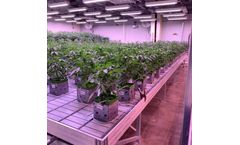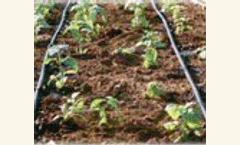Plant Canopy Articles & Analysis
19 articles found
How do you achieve the highest yields with your lighting system? As we know, increasing light intensity up to a certain species-specific point, results in a corresponding increase in yield. And when light levels are not optimized for production, or the type of crop you are growing, you are going to have slower flowering, poor root development and plant structure, as well as reduced yields. There ...
This radius matters in precision agriculture, when growers often want to consistently monitor thousands of plants week after week, year after year! To address this issue, we at Pollen Systems turn to technology like Ground Control Points (GCPs) to achieve the highest confidence in our imagery location accuracy. ...
There is no denying the importance of light for the growth of plants; however, there are many other environmental factors—such as temperature, moisture and nutrient availability, and soil type–that also influence plant growth. These factors do not act in isolation and are, many times, correlated. So, it is interesting to see how light works in combination with other resources to ...
Farm Fertilizer - A Double-Edged Sword The excessive use of fertilizers is one of the main causes of the environmental impact of industrial agriculture. The notion that more is better has caused more harm than good to farming, as well as the environment. Therefore, using the right amount of fertilizers is considered an important part of farm management. To this end, there has been a lot of ...
Atlas connects satellites feeds with our global crop maps to take a pulse on the world’s food production. Every day, it scans plant canopies across agricultural lands to check progress and conditions, while making comparisons against more than a decade’s worth of historical information. ...
If you are looking for a classic example of the circle of life, consider the forest canopy structure. A forest’s canopy structure is influenced by environmental and soil factors, and it also influences these factors in return. It is an aspect of forest ecology that is receiving more attention in this age of climate change emergency. The canopy structure is often overlooked, with most of the ...
Canopy Analysis for Crop, Forest & Plant Research The range of applications of canopy cover analysis is truly astounding. ...
The natural conditions in which plants and trees grow are neither uniform nor controlled. Many changes or fluctuations, even if they are temporary, can have a negative impact on and stress plants. ...
The natural conditions in which plants and trees grow are neither uniform nor controlled. Many changes or fluctuations, even if they are temporary, can have a negative impact on and stress plants. ...
LAI is calculated for a plant or can be scaled up to give readings for a whole crop or even a region. ...
LAI is calculated for a plant or can be scaled up to give readings for a whole crop or even a region. ...
As a plant that does not have sufficient lighting in veg will not produce as well in flower. ...
Plants are far better than humans at turning sunlight into food. But they’re not nearly as good as they could be: Thanks to quirks in the systems that have evolved to capture solar energy and use it to build sugars from carbon dioxide and water, the conversion efficiency of photosynthesis is but a few percent at best. With the need to produce more crops growing even faster ...
ByEnsia
At optimal and supraoptimal plant densities, maize receiving 165 kg ha–1 of side-dress N displayed strong N responsiveness, high NUE, pronounced crowding tolerance, and plant density independence. ...
Simulations are performed on thermal time, but can be on calendar time, in daily time-steps. The model uses canopy ground cover instead of leaf area index (LAI) as the basis to calculate transpiration and to separate out soil evaporation from transpiration. ...
The experiment consisted of one planting date in 2004, six in 2005, and four planting dates under two water regimes in 2006. Plant growth variables that were measured included leaf area index (LAI), canopy height, and aboveground biomass from emergence to the beginning of tasseling. ...
Our objective was to examine the role of canopy N reserves at maximum vegetative growth (R5.5) on seed yield, and seed protein, oil, and sulfur concentrations in the upper Midwest. ...
Producers of upland cotton (Gossypium hirsutum L.) are interested in alternative row spacings and planting patterns to improve productivity. We conducted factorial experiments for 3 yr in adjacent irrigated and nonirrigated fields at Milan, TN, of cotton grown in 25-, 76- and 102-cm rows, each planted in a solid and 2 x 1 skip-row pattern. Narrower rows and solid ...
Values were generally smaller for elevated [CO2] plants under water stress. Biomass increased with irrigation from 73 to 346 g plant–2. ...








